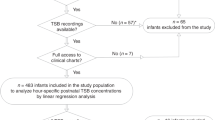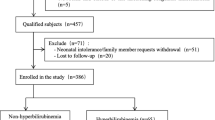Abstract
OBJECTIVE:
To evaluate the contribution of various factors to plasma bilirubin level in preterm infants with a birth weight of <1500 gm in need of mechanical ventilation for respiratory distress syndrome (RDS) during their first week of life.
METHODOLOGY:
A total of 50 very low birth weight (<1500 gm) preterm infants consecutively admitted to the neonatal intensive care unit were studied. Plasma bilirubin levels were determined every 8 hours for the first week of life. Data relating to daily body weight, daily fluid intake, age at onset of gavage feeds, daily caloric intake, and grade of intraventricular hemorrhage (IVH) were collected. Data relating to mechanical ventilation were collected every 4 hours as follows: fractional inspired O2, arterial PO2, arterial PCO2, and mean airway pressure. An arterial/alveolar PO2 ratio and a corrected oxygenation index were computed for the first 2 days of life.
A bilirubin index (BI), defined as the ratio of peak plasma bilirubin level to birth weight1/3, was used to study the association between bilirubin and the above variables. A BI was also used as a criterion for starting and discontinuing phototherapy. Multiple linear regression analysis was used to model BI.
RESULTS:
IVH (p < 0.0001), age at onset of gavage feeds (p < 0.003), oxygenation index (p < 0.007), and gestational age (p < 0.05) made a significant contribution to variations in BI (37.16%, 43.71%, 48.99%, and 53.33%, respectively).
CONCLUSION: Hyperbilirubinemia in ventilated preterm infants with RDS is most likely multifactorial; entities quite distinct from RDS (such as nutrition and IVH) may significantly contribute to its variation.
This is a preview of subscription content, access via your institution
Access options
Subscribe to this journal
Receive 12 print issues and online access
$259.00 per year
only $21.58 per issue
Buy this article
- Purchase on Springer Link
- Instant access to full article PDF
Prices may be subject to local taxes which are calculated during checkout
Similar content being viewed by others
Author information
Authors and Affiliations
Corresponding author
Rights and permissions
About this article
Cite this article
Kohelet, D., Goldberg, M. & Arbel, E. Factors Affecting Plasma Bilirubin in Preterm Infants Ventilated for Respiratory Distress Syndrome. J Perinatol 20, 285–287 (2000). https://doi.org/10.1038/sj.jp.7200371
Published:
Issue Date:
DOI: https://doi.org/10.1038/sj.jp.7200371
This article is cited by
-
Does Elevated Peak Bilirubin Protect from Retinopathy of Prematurity in Very Low Birthweight Infants
Journal of Perinatology (2003)



